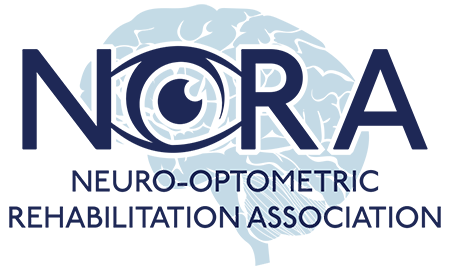MANALAPAN, NJ -- (November 5, 2018) -- -- Following a concussion or other Traumatic Brain Injury (TBI) there is often an interruption in communication between the eyes and the brain. Studies show that at least 50 percent of TBI patients suffer from visual dysfunctions, with one such study1 finding a 90 percent incidence of post-trauma visual complications, such as blurred vision, sensitivity to light, reading difficulty, headaches with visual tasks, and difficulties with eye movements.
Unfortunately, visual problems are often overlooked during initial evaluation of a concussion as some symptoms may not be present until days, weeks, or even longer following the incident. To assist concussion sufferers and their caregivers, as well as health care professionals who may see or be treating a patient following a concussion or other TBI, The Neuro-Optometric Rehabilitation AssociationTM (NORA) and Concussion Legacy Foundation (CLF) have developed a new educational resource titled Common Vision Problems & Symptoms Following a Concussion.
“Following a concussion, a regular eye exam often doesn’t reveal the extent that the visual process is affected from a concussive injury,” says Charles Shidlofsky, O.D., FCOVD, a Neuro Optometric Rehabilitation Optometrist in Plano, Texas. “While an individual’s eyes may appear to be healthy and they are seeing clearly, they may be experiencing Post Trauma Vision Syndrome (PTVS), a condition where more extensive visual processes in the brain may be affected.”
PTVS may impact one or more specific areas of visual function, so the effects can be varied. “PTVS can affect a person’s ability to read, comprehend, and sustain attention. It can also cause dizziness/vertigo and headaches/migraines as well as cause difficulties with tracking moving objects and making stationary objects appear to move,” explains Dr. Shidlofsky.
“Some concussion symptoms may only last a short period of time, while others can linger for months or even years, becoming Post-Concussion Syndrome and adversely affecting the way a person functions in their activities of daily living,” adds Robert Cantu, M.D., co-founder and medical director of the Concussion Legacy Foundation. “If you notice any changes in your vision following a concussion, especially blurred or double vision, don’t ignore them. Early diagnosis leads to appropriate treatment and/or referral to a specialist.”
Following a concussion or any TBI, one type of rehabilitation is often not enough to address all of a patient’s needs, according to Dr. Cantu. “An interdisciplinary, integrated team approach can play a vital role in rehabilitation of concussion patients,” he explains. Rehabilitation team members may include neurologists, physical and occupational therapists, speech-language pathologists, neuropsychologists, audiologists, and others.
Both organizations offer resources to help patients and caregivers find the help they need following a concussion. Concussion Clinics is a free online tool provided by the Concussion Legacy Foundation that is designed to connect patients with local medical providers and clinics that treat concussions. CLF’s Post-Concussion Syndrome (PCS) Resources are an online tool for patients and families experiencing lingering symptoms after a concussion. The Neuro-Optometric Rehabilitation Association’s website’ features a “Find a Provider” tool for access to eye doctors who specialize in brain-injury related visual problems.
Common Vision Problems & Symptoms Following a Concussion can be viewed and downloaded on NORA’s Patient Caregivers Resource page and CLF’s Post-Concussion Syndrome (PCS) Resources page.
ABOUT NORA
Neuro-Optometric Rehabilitation Association, International (NORA) is an inter-disciplinary group of professionals dedicated to providing patients who have physical or cognitive disabilities as a result of an acquired brain injury with a complete ocular health evaluation and optimum visual rehabilitation education and services to improve their quality of life. For more information, visit noravisionrehab.org. Follow NORA on Facebook, LinkedIn, Twitter, and YouTube.
ABOUT THE CONCUSSION LEGACY FOUNDATION
The Concussion Legacy Foundation is a 501(c)(3) nonprofit organization. It was founded by Robert Cantu, MD, and Chris Nowinski, PhD to solve the concussion crisis by advancing the study, treatment and prevention of the effects of brain trauma in athletes and other at-risk groups. For more information, please visit ConcussionFoundation.org. Follow CLF on Facebook, Twitter, Instagram, LinkedIn and YouTube.
References
1. Ciuffreda KJ, Kapoor N, Rutner D, Suchoff IB, Han ME, Craig S. Occurrence of oculomotor dysfunctions in acquired brain injury: a retrospective analysis. Optometry 2007;78(4):155-61.
For further information, contact:
Gary Esterow
Esterow.NORA@gmail.com
908-216-5200
Julia Manning
jmanning@concussionfoundation.org
515-201-7199
